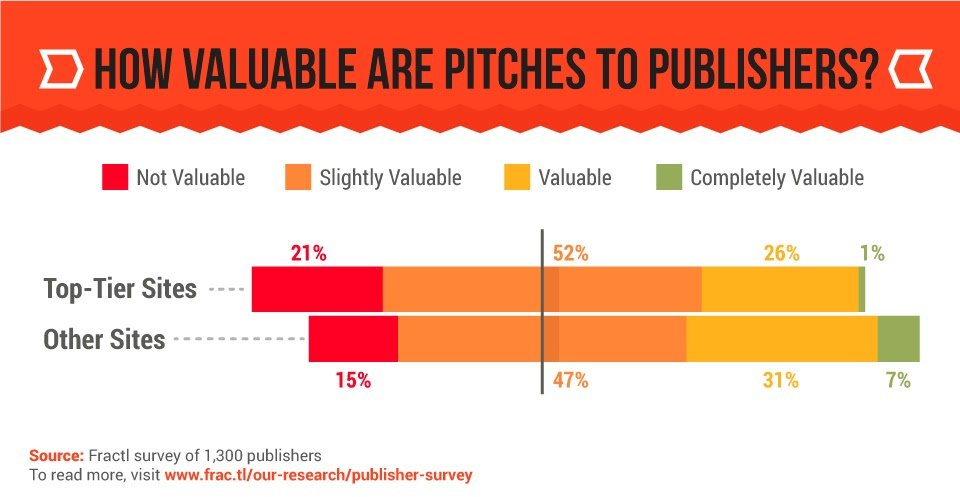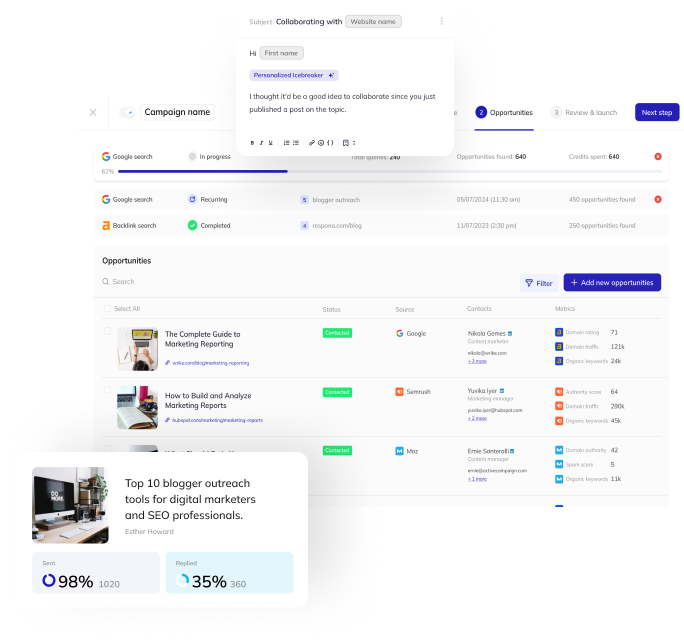57% of professional publishers receive anywhere from 50 to over 500 media pitches every single week.
So, in order to be heard, your pitch must stand out.
In this article, we’ll be walking through the step-by-step process of media pitching from preparing your pitch to finding media opportunities and their contact information to personalization.
Let’s get started.
Link building cheat sheet
What is Media Pitching?
Media pitching in 2024 remains the bloodstream of public relations and digital marketing; it is the practice of presenting story ideas and additional information to journalists, editors, and producers in a manner that piques their interest and persuades them to cover the topic in their publications or broadcasts.
At its core, media pitching is about getting your story out to a wider audience through the credibility of the press.
It’s a targeted approach aimed at specific journalists who have the capacity to reach and engage the public.
The importance of media pitching has not diminished in 2024, as it’s an essential tool for anyone looking to raise awareness, shape public perception, or drive action around a person, product, or initiative.
According to a study by Fractl, only 52% of journalists consider the media pitches they receive valuable.

To make sure your media pitch is one of them, you need to keep three central elements in mind:
- Value: Your PR pitch must offer something worthwhile to the journalist and their audience. Their time is limited, and only the most compelling, newsworthy, or unique stories will make the cut. Data-driven insights or an enticing case study/story can provide the edge your pitch needs. Value can be demonstrated in various forms—through original research, thought leadership, or timely relevance—but it must be apparent from the outset of your pitch why covering your story would benefit their readers or viewers.
- Avoiding Self-Promotion: Effective media pitching is not self-serving; it’s essentially a service to the journalist. It’s not about promoting your brand blatantly but about presenting a story that’s too good, too relevant, or too timely for the journalist to pass up. Overly promotional pitches often get discarded. Your goal should be to subtly align your brand with a story that resonates on its own merits.
- Building relationships: Media pitching isn’t a one-off transaction but a long-term investment in PR professional relationships. This is crucial in 2024, with the oversaturated landscape where it’s almost impossible to cut through the noise without connections. A pitch letter should be the start of a dialogue—a chance to demonstrate you understand the journalist’s beat and interests and that you are a reliable source of future stories. Crafting pitches with a personal touch, acknowledging previous work by the journalist, and following up respectfully can kickstart these media relations.
Media pitches are not to be confused with press release distribution.
A successful media pitch is a short, personalized proposal sent to a journalist or media outlet aiming to spark interest in a story idea.
It’s intended as a conversation starter, often tailored to the recipient’s interests.
On the other hand, a press release is a formal, comprehensive statement prepared for distribution to multiple media outlets, outlining the complete details of a news item.
As an example, take a look at Stephen King’s press release about his new comic book series, American Vampire:

It’s ready-to-publish content marketing copy designed to inform rather than engage in a dialogue, providing journalists with all the facts needed to craft a story.
Step 1: Prepare your Pitch
Let’s get into the step-by-step process of creating your PR pitching campaign.
We’ll be using our own tool, Respona, throughout the whole campaign.
In fact, it comes with a pre-designed campaign template for news outreach – however, we’ll be creating an advanced (non-templated) campaign for this media pitch example.
The first step is to prepare your media pitch.

Your proposal should clearly demonstrate its significance to the journalist’s interests or beat.
Personalize your pitch by referencing work that is both topical and pertains to the journalist’s recent media coverage.
For example, if you’re reaching out to a technology columnist who has been tracking the impact of artificial intelligence on employment, an effective media pitch about innovative job creation as a result of AI advancements could catch their eye.
Let’s use the “Opportunity title” variable – it will automatically pull the titles of your target journalists’ titles into each pitch.

If commonalities exist—such as another PR pro you both know, shared alma maters, or professional intersections—mention them.
This could help bridge the gap between a cold pitch and making an aquantance.
Showing you understand and appreciate their reporting can be incredibly persuasive – for example, by mentioning something they talked about in their latest article. .
In fact, you can automate this with Respona.
Let’s insert an AI Icebreaker variable – it will automatically “read” through your prospects’ content and come up with unique personalizations for every opportunity in your campaign based on their articles.

Next up, address the “What’s in it for me?” question from the journalist’s perspectiv.
Break down the findings or unique perspectives that your story offers, ensuring they’re directly aligned with the journalist’s audience’s interests.
Doing so briefly and clearly via bullet points can highlight the crucial aspects without overwhelming the recipient.
Remember that relevance does not just mean tying your pitch to trending topics.
It also means conveying credibility and familiarity with the subject matter.
If your pitch is about a study your company has conducted, briefly explain your research process and its findings.

This builds your credibility and simultaneously emphasizes that you do, in fact, know what you’re talking about.
Capturing journalists attention from the get-go is essential for getting opens, and your subject line can make or break your email pitch.
It should be brief, contextual, and cater to the curiosity of the recipient without resorting to clickbait tactics.
For instance, a subject line like “New Study on Tech Adoption: Data from (x) Countries” offers both novelty and context, increasing the likelihood of your email being opened.

Let’s also add a single follow-up, 5 days after our initial pitch. In our experience, one follow-up is enough, and any further messages only increase your likelihood of getting flagged as spam.

Speaking of spam, let’s make sure to check our email for spam words and add an unsubscribe link to reduce our chances of getting flagged.

When your perfect pitch is complete, move on to the next step.
Step 2: Find Media Opportunities
Respona’s search engine is built with Google and has two modes for searches: a standard Google search and a Google news search.

It can run several queries at the same time and will automatically add relevant opportunities to your campaign, in real-time.
Let’s also apply the date range filter to the last three months to make sure we only target active journalists or reporters, and reference recent content.

After clicking “continue”, let’s also apply some additional SEO filters to narrow down the results even further.
By default, Respona is integrated with Moz, and those filters are available to all users. However, if you have an account with Ahrefs or Semrush, you may also connect it to Respona and use those tools’ proprietary filters instead.

We, for example, like to limit our results to publications with a Domain Authority of at least 20, but no more than 90 so that our opportunities are big enough to be valuable, but not so big as to be unreachable.
Click “Continue” again to access Respona’s email finder.
It’s already set up to find journalists’ contact information while skipping catch-all domains and generic emails.
This ensures that the emails it will find will belong to writers and not just some generic “[email protected]”.
It also finds email addresses in real-time as opposed to using a media database.

In the next window, let’s also provide our AI personalizations with some additional instructions.
These can be both general guidelines for tone and style as well as examples of your previous personalizations as training data.
Last but not least, before running the automation, let’s toggle the “recurring” option.
This will automatically re-run the search every couple of weeks and add any new articles that have been released in the meantime into our campaign.

After you click “Run automation”, Respona will start looking for relevant publications along with their journalists’ contact information – and personalizing your media pitches, all at the same time.
Results will start appearing on your screen as soon as they are found:

It’s done entirely in the cloud, so you don’t need to keep the tab open and wait for it to complete.
While it’s running, you can start working on another campaign or task.
When it’s complete, Respona will send you an email – so you can move on to the final step.
Step 3: Personalize
Here, all of your variables – both regular like “first_name” and AI-powered, will be populated.
You’re welcome to review them and make any manual edits you deem necessary.

In addition to email addresses, Respona also finds the LinkedIn profiles of your target journalists.
You can find them on the right side of the screen, next to their names.
We recommend sending your prospects a connection request on social media in addition to your email to put a face to your outreach and increase the chances of getting a reply.
When everything’s done and your campaign is launched, all that’s left for you to do is look out for responses.
Link building cheat sheet
Now Over to You
So, to sum it up, media pitching is all about finding relevant journalists and figuring out the perfect angle to approach them from.
Your media pitch should clearly outline how the journalist will benefit from covering your story – and sum it up in a few sentences.
If you need help running your own media pitch campaign, don’t hesitate to start your 14-day free trial with Respona to see how we can help first-hand.
Frequently Asked Questions (FAQ)
What is media pitching and why is it important in 2024?
Media pitching is the process of presenting story ideas or information to journalists and editors in hopes that they will publish or broadcast your content.
In 2024, amidst an overwhelming flood of information, a well-crafted pitch can help you cut through the noise, grab media attention, and get your narrative in front of the right target audience – whether you’re running a small business or an enterprise.
How do I find relevant media contacts to pitch to?
Research is key. Start by identifying publications and segments within media outlets that are relevant to your story.
Respona’s bulk email finder and verifier will help you get a hold of the journalists working for those publications – and even help with media monitoring through recurring campaigns. .
What should I include in my media pitch?
Your personalized pitch should be concise and direct, typically not exceeding a few paragraphs.
It should include a compelling subject line, a brief introduction of yourself, an overview of your story idea, why it’s relevant now, any unique angles, and a clear call to action.
Make sure to tailor the pitch to the recipient’s beat or area of interest.
How can I increase the chances of my pitch being accepted?
Timeliness, relevance, and personalization are paramount.
Understanding the media outlet’s audience and tying your pitch to current trends or events can greatly increase its appeal.
Always personalize each pitch email to show that you are familiar with the journalist’s work, and explain succinctly why your story matters.
What are the common mistakes to avoid in media pitching?
Avoiding common mistakes is essential for a successful pitch.
Sending mass, impersonal emails, neglecting to do proper research on the journalist, failing to follow up appropriately, and providing insufficient or overly detailed information can all lead to your pitch being overlooked.
Craft each compelling pitch with care and follow professional etiquette.






